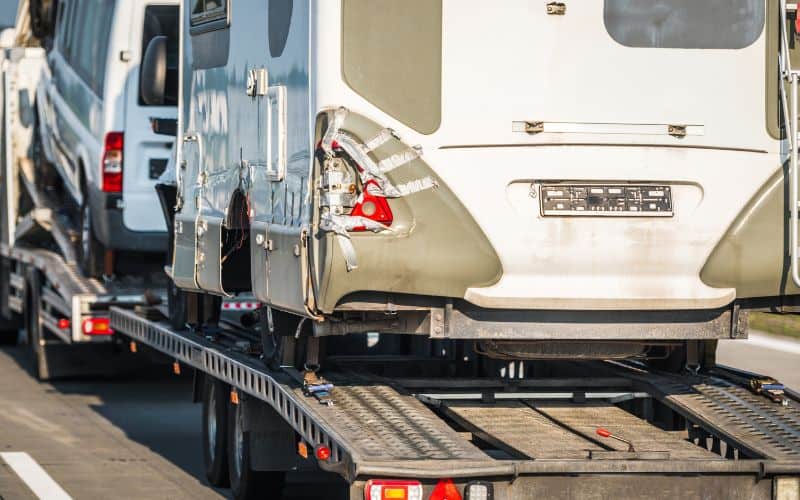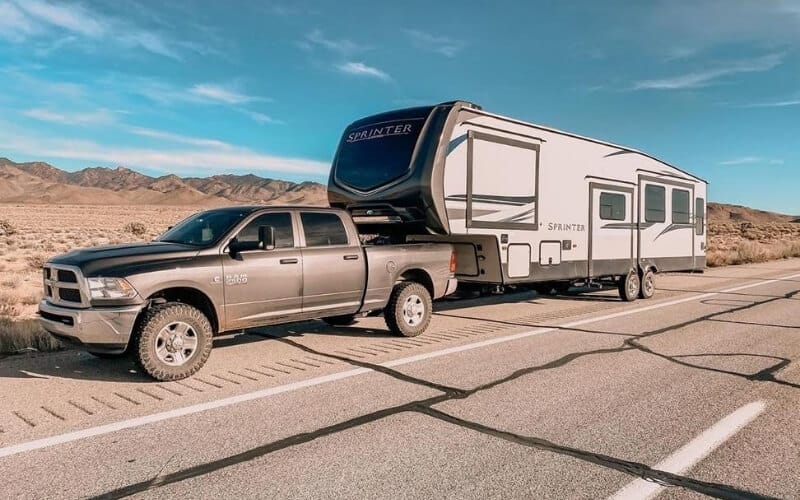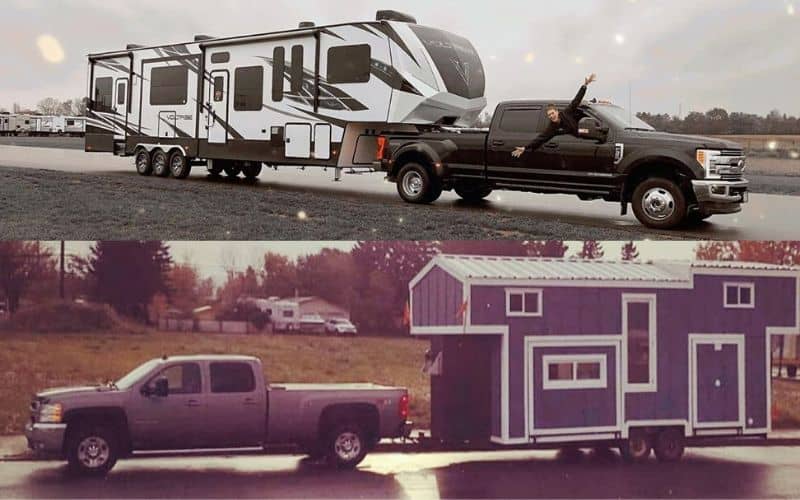It’s an unfortunate reality, that just like cars and trucks, RV’s also too depreciate. Though how they depreciate and the rate that they depreciate can vary depending on the RV, how it’s cared for, and the brand reputation.
If you are thinking about buying or selling an RV, you might be wondering how much does an RV depreciate per year?
RVs depreciate quickly, A brand-new RV loses somewhere between 20–25% of its value just by driving it out of the dealership’s lot, another 10% at the end of the first year. From years two to five, depreciation ranges from 15% to 18% per year. As a rule of thumb, in ten years, RVs lose 60% or more of their initial purchase price.
Though there are certainly some factors that can swing this trend in a slightly more favorable direction.
Yet while RV’s do depreciate similarly to cars, trucks, and other vehicles, some things can influence how well they hold or lose their value.
To really understand if you are getting or giving a fair deal on an RV sale, we are going to have to roll up our sleeves and take a look at the finer points of RV depreciation.
This includes things like the age, mileage the make and model, as well as how well it’s maintained. There are also less obvious factors that might influence an RV’s value.
The Primary Factors Affecting RV Depreciation
Several factors play into how fast an RV depreciates. While the general passage of time is a powerful factor, it’s not the only thing to consider when trying to determine an older RV’s true value.
If you are buying or selling a pre-owned RV, you need to take the following factors into account in the asking or offer price.
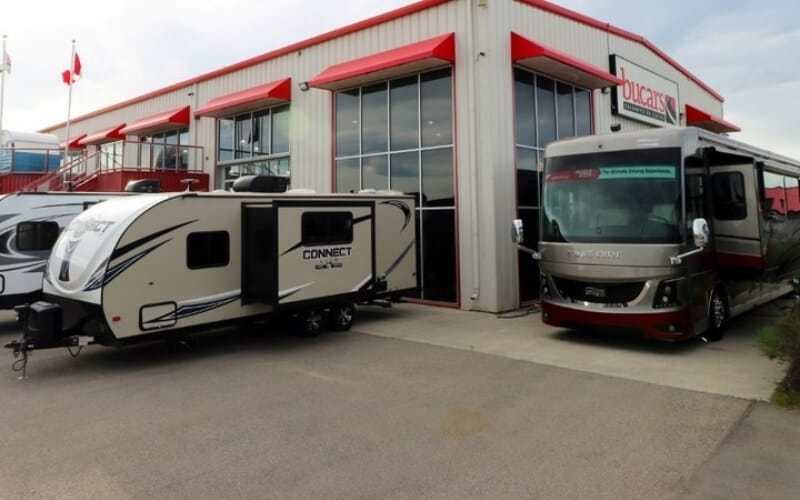
1: The Class Or Type Of RV
Motorhomes in particular are rated under three different classes. Class A Motorhomes are the largest of all RV and tend to carry a high price tag, whereas Class B motorhomes are small, to the point where many are little more than large campervans. With Class C motorhomes landing in the middle between the two.
Since motorhomes have engines they tend to have miles and other maintenance considerations that affect their depreciation and resale value.
If you are buying or selling a motorhome, comprehensive maintenance records and accurate odometer readings will factor into the asking or offer price.
When it comes to travel trailers, fifth-wheel trailers, and other types of campers, the physical condition is a stronger factor.
This includes things like the structural soundness of the trailer, especially the nose and tongue, as well as the wheel bearings and axles.
2: External Damage Impacts RV Depreciation Value
When it comes to the value of an RV the external appearance does matter. I’m not talking about the possibly outdated color scheme or graphics, but physical defects like dents, dings, scratches, and rust can cause drastic depreciation.
Not only are these things cosmetic defects, but they could speak to how the RV was treated by the previous owner, or be an indicator of an impending mechanical problem.
Ultimately, the more rust spots, dings, dents, and scratches you see on an RV, the more suspicious you should be about its true value.
3: Maintenance Records & Repairs
Just like a car or pickup truck, an RV needs to be properly maintained. This is especially true with motorhomes that have engines and a lot of moving parts like power retractable slide-out sections or awnings.
Though even travel trailers and fifth wheels also need routine maintenance, like greasing wheel bearings, and proper winterization.
Ideally, if you are thinking about buying an RV you should ask to see maintenance records and repair receipts.
If the previous owner doesn’t have those available, it could be a statement about how little care the RV has seen in its life.
If you are selling an RV and you want to get top dollar for it, then be prepared to show a prospective buyer proof that you have been truly taking good care of your investment.
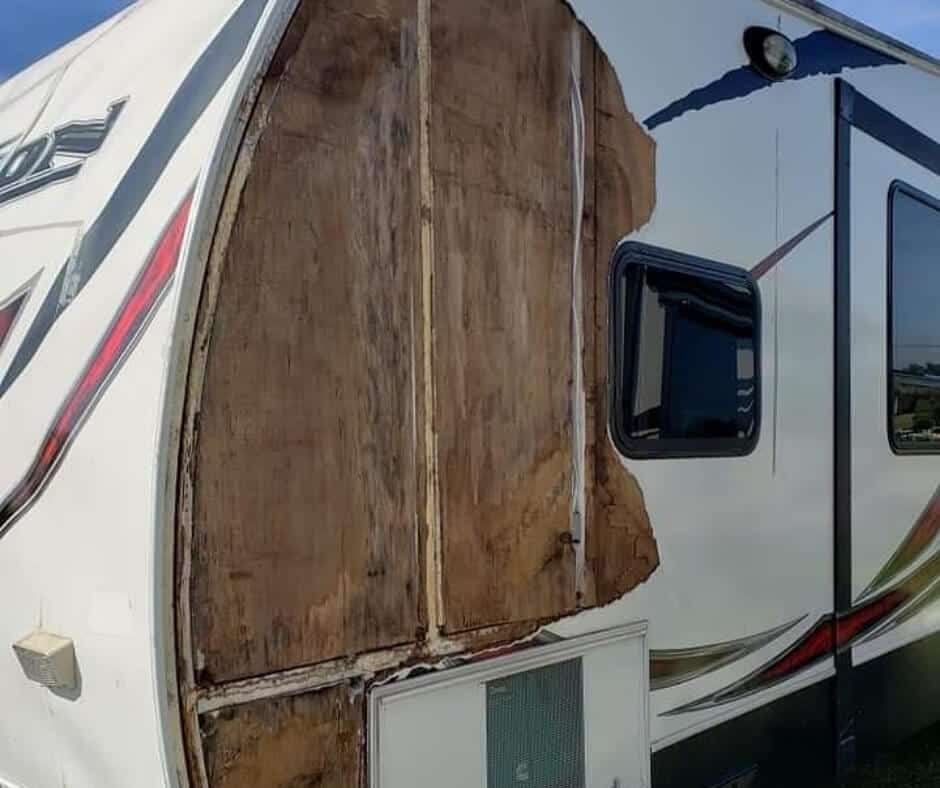
4: Noticeable Signs Of Water Damage
Water is the universal solvent, and it has an amazing knack for getting into everything. Skylights and window leaks are common problems with a lot of older RVs.
Though you also need to give a good hard look at any toilets, showers, or sinks. If you get a chance, try to also get your eyes on the freshwater, gray water, and black water storage tanks to look for any signs of leaks.
Not only can errant water damage an RV’s interior and cause other mechanical problems, but it’s also a prime indicator of a possible mold problem.
This can be a major factor if someone in your family has respiratory health issues or is prone to react to mold-infested environments.
If you do happen to find signs of a past water problem, be sure to ask for repair records or look for signs of a professional repair job.
This might include replacement plumbing fittings or updated seals and caulking around windows and skylights. If you don’t see any proof of this, then the valuation for the RV should be lowered.
5: The Manufacturer’s Brand Name Can Also Affect RV Depreciation Value
Just like with cars, pickup trucks, and boats, certain manufacturers have a higher reputation for offering RVs with the superior material build quality and sound engineering principles.
Whereas others are known for a “That’ll Do” mentality in the RV assembly facility.
Major names like Winnebago, Airstream, and Coachmen have spent decades earning a reputation for producing quality RVs that stand up well to the tests of time.
This then factors into a slower rate of depreciation as well as holding their value at resale prices.
Though there is a little bit of a tradeoff here in the first five years of an RV’s life. Big manufacturers with loyal customer bases and true “Brand Power” tend to ask a little more for their models.
Then, like all RV’s they take that initial 20 to 25% depreciation hit when you drive them off the lot.
It ultimately means that a well-known RV like Winnebago has farther to fall in depreciation for the initial owner, and they might try overly hard to recapture some of them if they are selling the RV in the first five years after purchasing it from the dealership.
6: Damaged Or Outdated Appliances Can Affect An RV’s Depreciation
Most RV’s come with a few appliances as standard. In the case of a large Class A motorhome, luxury fifth wheel, or decked out Class C motorhome you might be talking about TVs, refrigerators, full bathrooms, ovens, and microwaves as part of a fully functioning kitchen.
A few luxury models might even have a jacuzzi tub and laundry facilities.
With these, the state of the appliances is a stronger factor. A beat-up conventional refrigerator that has taken ten too many knocks on bumpy roads could easily conk out on you a few months down the line, leaving you with an expensive headache and a higher overall cost of ownership.
The more appliance concerns there are, the steeper the depreciation cut should be.
On the other end of the spectrum, a small travel trailer or teardrop camper might come with little more than a small flat-screen TV and a microwave.
The state of these appliances will have little to do with the overall value or deprecation rate of the RV.
Ultimately, the more appliances the RV has the more those appliances will impact its value and overall depreciation. You also need to factor in the cost to upgrade tech items in an older RV.
7: How It Was Stored When Not In Use
Unless you are buying a pre-owned RV from a full-timer, chances are the RV will spend some, if not the majority of its life in storage.
An RV that is stored outdoors is more prone to damage from the elements. This is even more likely to be an issue if the previous owner lived in an area prone to extreme cold in the winter or extreme heat in the summer.
Ideally, you want to place a higher value on an RV that was stored indoors or inside some sort of climate-controlled facility.
Keeping an RV in a temporary awning structure or under a tarp is not considered “Indoor Storage.”
In reality, storing an RV this way can trap excess moisture and humidity leading to problems with water damage and potential mold infestation issues.
8: Factoring In MSRP In RV Depreciation
The Manufacturer’s Suggested Retail Price, is essentially an inflated price that is assigned to each model offered by the dealership.
This is the price the manufacturer is recommending that the dealership offers to you. The price the dealership actually pays the RV manufacturer is called the “Invoice Price.”
The difference between these two is the potential wiggle room you have when negotiating the final price you purchase the RV for when buying a new model.
Different dealerships use different gimmicks to get you to choose their models over their competitors.
Some RV dealerships stick to the MSRP has a hard-line without any room for negotiations, and others will work with you.
Most RV dealerships will have special promotions at different times of the year or for different special occasions.
Some RV resellers will use the MSRP as their starting point for calculating depreciation and their asking price when selling their preowned RV.
Though this becomes increasingly suspect in RVs that are more than five years old.
Estimating RV Depreciation Rates By Type
The reality is that motorhomes and trailers depreciate differently. This is due to the presence of an engine, as well as other mechanical parts that require routine maintenance.
Most motorhomes tend to have more appliances than a travel trailer or fifth-wheel trailer of a similar size and price range.
So, it helps to estimate the depreciation rate by the different types of RVs when dialing in a fair asking or offering price for a pre-owned model.
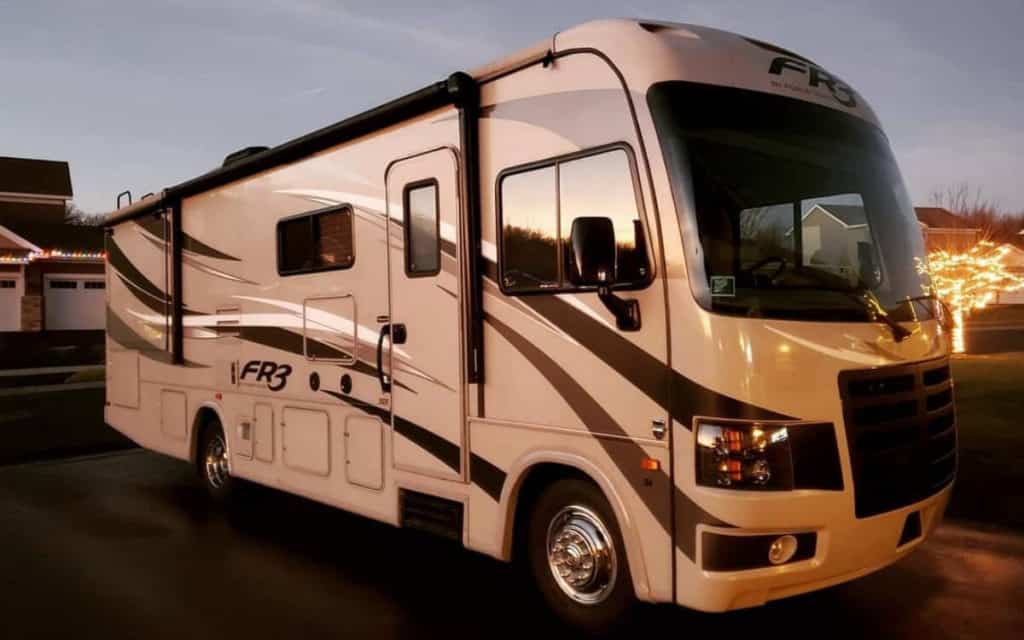
The Depreciation Rate Of A Class A Motorhome
Class A motorhomes are the largest of all RVs. They can be up to 45 feet long and potentially cost between $100,000 to even $200,000 or more for “Luxury” models.
Unfortunately, Class A motorhomes also tend to depreciate quickly. To the point that a Class A RV can lose 30% of its value in just the first three years and can depreciate by as much as half within 10 years after you drive it off the dealership’s lot!
Though the depreciation rate of a Class A motorhome is not a constant or even a consistent curve. In the first year of life, you can expect a Class A motorhome to lose roughly 20% of its value.
It can lose up to 22 to 25% by the end of year two. This is a little hard for some Class A motorhome owners to deal with as the depreciation value tends to vanish faster than the “Like New” smell.
At three years old the depreciation rate starts to level out a little bit for most Class A motorhomes, at around 25 to 30% less than the original purchase price.
From here it takes a gradual tumble to roughly 50 to 60% depreciated value at 10 years old.
Beyond ten years it gets harder and harder to predict how the RV will depreciate. This is due in part to the engine, and how maintenance issues can compound the overall condition.
As a general rule of thumb, an “Average” Class A Motorhome will have lost 75% of its value from the purchase price at around 15 years of age.
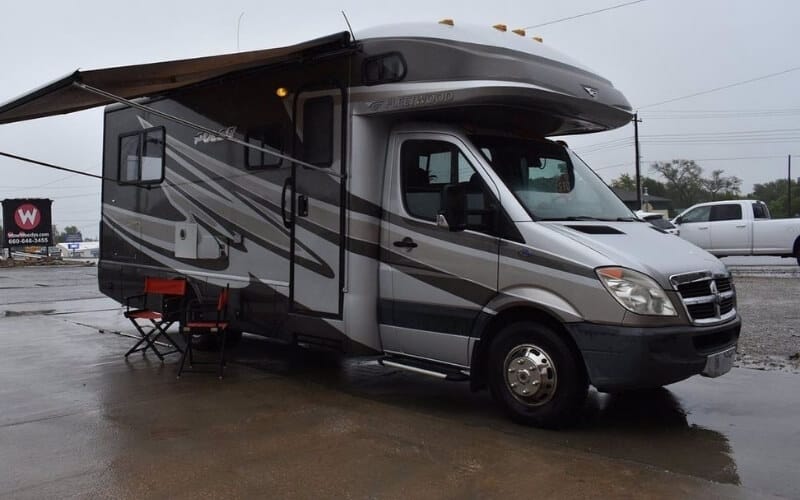
The Depreciation Of A Class C Motorhome
Class C motorhomes are the next step down from Class A motorhomes. They are a little smaller, though some of the biggest Class C motorhomes can measure in at 33 feet long.
They tend to be popular as they are larger than the campervans of the Class B motorhome segment, though not the colossus of Class A motorhome.
They are also relatively easy to drive, which makes them very popular for vacationing families.
The problem here is that traveling families with children have a knack for beating up Class C motorhomes before they eventually outgrow them or start looking to downsize after the kids have left the nest.
So, when appraising a Class C motorhome be sure to give extra scrutiny to the condition as well as the maintenance and storage records.
With most Class C motorhomes you see the same 20% depreciation value when you drive it off the dealership’s lot.
Though the depreciation curve of a “Properly Maintained” Class C motorhome doesn’t take nearly as steep of a dive.
By the fifth year of life, the average Class C motorhome only sees roughly 35 to 40% depreciation.
By the time a Class C motorhome celebrates its tenth birthday, it should have depreciated roughly 50% from its original purchase price.
Again, this is assuming that it’s been properly cared for and maintained without any obvious signs of abuse or neglect.
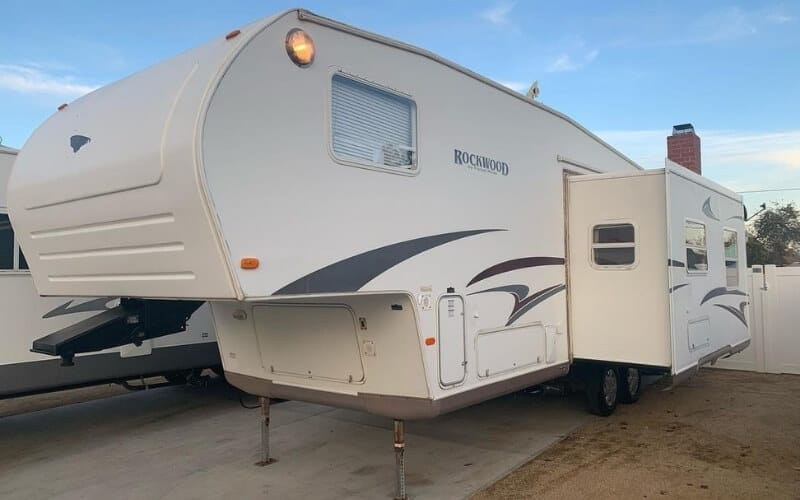
Travel Trailer & Fifth Wheel Camper Depreciation
Travel trailers and fifth-wheel trailers depreciate similarly. While they can be very different in size, with some travel trailers being as short as 14 feet or smaller, they tend to have a lot of similarities when it comes to how they’re valued.
This is due in part to the fact that they don’t have the heavy-duty engines of a motorhome and a lot of similar accommodations in the interior.
When properly maintained the differences in length between an average travel trailer and fifth wheel are minimal factors in how the arc of their depreciation curve.
Though just like Class A and Class C Motorhomes you still see the same 20 to 25% depreciation when you drive them off the dealership lot.
Though the curve slows dramatically from there. Indeed, there are some travel trailers and fifth wheels from established brands that only depreciate around 30% under the original purchase price by the end of their fifth year!
From there the slide of the depreciation curve is still slow. To the point that after a decade of life, with routine maintenance and proper seasonal storage an average travel trailer or the fifth wheel might only depreciate to 40 or 45% from the original purchase price.
This makes them a relatively sound investment over the long haul. You could purchase a new travel trailer or fifth-wheel when your child is 7 or 8-years old, and then sell it ten years later to help pay for their first year of college tuition.
Though once a travel trailer or fifth-wheel camper starts to get beyond 14 or 15 years old, the value starts to take a serious nosedive.
This is usually related to structural issues or problems with the axles, or damage caused by poorly maintained wheel bearings.
Frequently Asked Questions
Is It A Good Idea To Buy A New RV?
This is a quintessential question asked by all prospective vehicle owners. I mean who doesn’t love that “New” smell, and the confidence of knowing that someone else hasn’t previously abused your new major investment.
Of course, the tradeoff here is that you will eat the inevitable depreciation that comes when you drive any new vehicle or piece of equipment off the dealership’s lot.
You also face a pretty steep insurance premium cost when you buy a new RV. This can be even higher if you financed it, as most lenders require an additional level of collision or comprehensive insurance until you have paid off the balance of the loan.
What Age Does RV Depreciation Start To Level Off?
If possible, you want to find a similar RV that is around 5 years older. This is sort of the sweet spot where a lot of preowned RV’s have taken a serious nosedive in their perceived market value, yet physically and mechanically they are likely to be sound.
Five years is also that point where the depreciation drop starts to level off. This means you can buy it with confidence from a private seller or a consignment lot, and still get good trade-in or resale value if your family happens to outgrow it a few years down the line.
Does Usage & Storage Impact The Depreciation Of An RV?
Some private sellers will tout just how little their RV has been used as a selling point. Indeed some families buy an RV and only take it on one or perhaps two trips a summer. It then spends the rest of the year sitting in storage.
In a situation like this, you want to ask some key questions before considering their point. Right off the bat, you want to see records that it was properly stored and winterized.
If they simply drove it into the yard and parked it for 9 months as-is, then I would recommend being leery.
Things like water lines and water heaters are prone to corrosion and damage from the natural freeze-thaw cycle.
The water system might work just fine when you try it once, only to become a recurring problem after you sign on the dotted line.
This same sort of logic applies to the hydraulic system and any other moving parts that need lubrication to operate properly.
If the previous owner or the consignment dealership is arguing a higher value and they can’t produce proper paperwork demonstrating that the lesser-used RV was properly cared for when not in use, then you should worry about inheriting someone else’s problems.
If you are the seller, be prepared to offer a clear explanation of why the RV was used so little and try to be as upfront as possible when it comes to maintenance documentation.
This will go a long way toward easing a potential buyer’s concerns and encourage them to accept your honest valuation of the RV you are selling.
How Does Mileage, & Engine Maintenance Affect Motorhome Maintenance?
With motorhomes, the age of the drive train and how it’s been maintained will factor into its deprecation and resale value.
Though mileage isn’t as big of a factor in motorhome depreciation as it is with a car or pickup truck.
The truth is that a lot of motorhome’s die from some other major physical or mechanical fault before the engine gives up the ghost.
Here again, this is an area where a potential buyer wants to see comprehensive maintenance records before agreeing to a seemingly high valuation.
On the other side of the coin, if you are trying to sell your RV with a high valuation above the perceived depreciation rate, then be prepared to demonstrate that the engine and other critical mechanical systems have been thoroughly, if not professionally maintained.
Conclusion
If you are thinking about buying a new RV, then you are going to have to accept a natural 20 to 25% depreciation just for driving it off the lot.
You might be able to flatten this curve a little bit if you buy a new RV during a dealership promotion or a seasonal clearance sale event.
This will give you more negotiating wiggle room in hopes of getting a purchase price that’s as close as possible to the dealership’s invoice price, rather than the always-inflated MSRP.
If you are buying or selling a pre-owned RV, then condition, maintenance, and storage are going to all play a part in the depreciation valuation process.
Regardless of class or type an RV that has been well-maintained, properly winterized, and stored with care, is always going to have less depreciation in the asking price than one that has been abused or endured slipshod maintenance.
If you are looking for an RV for a decade or so of fun family adventures, you might want to lean toward a Class C motorhome, travel trailer, or a fifth-wheel camper.
When properly maintained they will depreciate less than a lumbering Class A motorhome. Ultimately, leaving a little more return in resale value when it comes time to upgrade or downsize.

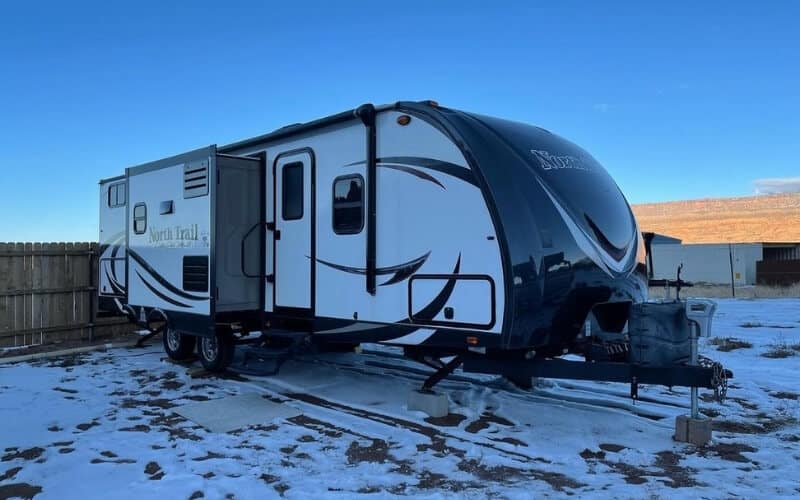
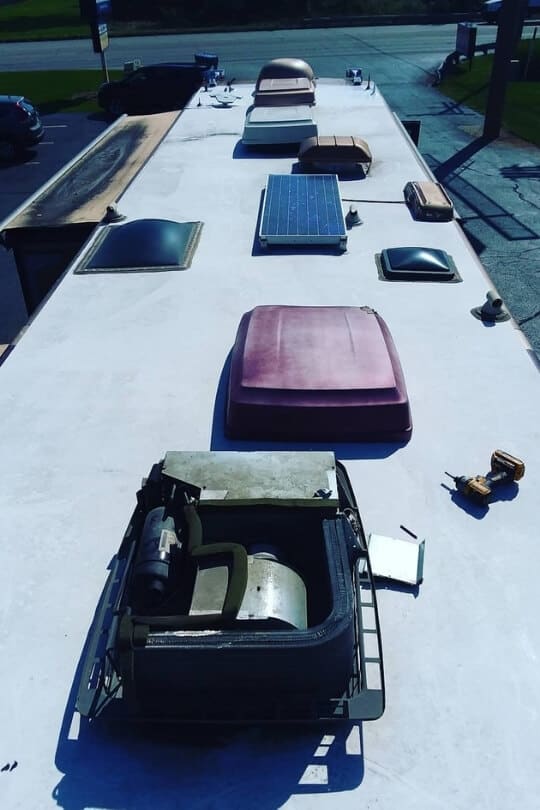
![5 Best RV Golf Cart Carriers in [currentyear]- Top Reviews by RV Experts 8 Best RV Golf Cart Carrier Options You Should Consider](https://www.rvingknowhow.com/wp-content/uploads/2022/05/Best-RV-Golf-Cart-Carrier-Options-You-Should-Consider-150x150.jpg)
![6 Best RVs with Motorcycle Storage for Epic RV Camping Experience in [currentyear] 9 The Best RVs With Motorcycle Storage](https://www.rvingknowhow.com/wp-content/uploads/2021/05/The-Best-RVs-With-Motorcycle-Storage-150x150.jpg)
